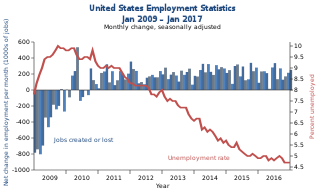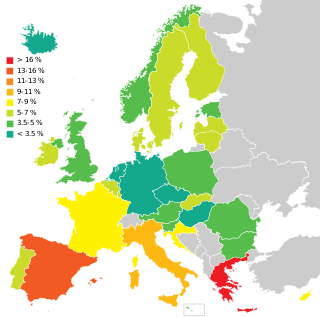
Unemployment, according to the OECD, is people above a specified age not being in paid employment or self-employment but currently available for work during the reference period.

The United States had an official estimated resident population of 334,914,895 on July 1, 2023, according to the U.S. Census Bureau. This figure includes the 50 states and the Washington, D.C. but excludes the population of five unincorporated U.S. territories as well as several minor island possessions. The United States is the third most populous country in the world, and the most populous in the Americas and the Western Hemisphere. The Census Bureau showed a population increase of 0.4% for the twelve-month period ending in July 2022, below the world average annual rate of 0.9%. The total fertility rate in the United States estimated for 2022 is 1.665 children per woman, which is below the replacement fertility rate of approximately 2.1. By several metrics, including racial and ethnic background, religious affiliation, and percentage of rural and urban divide, Illinois is the most representative of the larger demography of the United States.

The demography of the Republic of Bulgaria is monitored by the National Statistical Institute of Bulgaria. Demographic features of the population of Bulgaria include population density, ethnicity, education level, health of the populace, economic status, religious affiliations and others.

In economics, a discouraged worker is a person of legal employment age who is not actively seeking employment or who has not found employment after long-term unemployment, but who would prefer to be working. This is usually because an individual has given up looking, hence the term "discouraged".
The economies of Canada and the United States are similar because both are developed countries. While both countries feature in the top ten economies in the world in 2022, the U.S. is the largest economy in the world, with US$24.8 trillion, with Canada ranking ninth at US$2.2 trillion.
The Current Population Survey (CPS) is a monthly survey of about 60,000 U.S. households conducted by the United States Census Bureau for the Bureau of Labor Statistics (BLS). The BLS uses the data to publish reports early each month called the Employment Situation. This report provides estimates of the unemployment rate and the numbers of employed and unemployed people in the United States based on the CPS. A readable Employment Situation Summary is provided monthly. Annual estimates include employment and unemployment in large metropolitan areas. Researchers can use some CPS microdata to investigate these or other topics.

The Organisation for Economic Co-operation and Development defines the employment rate as the employment-to-population ratio. This is a statistical ratio that measures the proportion of a country's working age population that is employed. This includes people that have stopped looking for work. The International Labour Organization states that a person is considered employed if they have worked at least 1 hour in "gainful" employment in the most recent week.

Unemployment in the United States discusses the causes and measures of U.S. unemployment and strategies for reducing it. Job creation and unemployment are affected by factors such as economic conditions, global competition, education, automation, and demographics. These factors can affect the number of workers, the duration of unemployment, and wage levels.

Unemployment in the United Kingdom is measured by the Office for National Statistics. As of February 2024, the U.K. unemployment rate is 3.8%, down from 3.9% in January.

Youth unemployment is a special case of unemployment; youth, here, meaning those between the ages of 15 and 24.

Unemployment rates in Spain vary across different regions of the country, but they tend to be higher when compared to other Western European countries.
Statistics on unemployment in India had traditionally been collected, compiled and disseminated once every ten years by the Ministry of Labour and Employment (MLE), primarily from sample studies conducted by the National Sample Survey Office. Other than these 5-year sample studies, India had historically not collected monthly, quarterly or yearly nationwide employment and unemployment statistics on a routine basis. In 2016, the Centre for Monitoring Indian Economy, a non-governmental entity based in Mumbai, started sampling and publishing monthly unemployment in India statistics.

Unemployment in Poland appeared in the 19th century during industrialization, and was particularly severe during the Great Depression. Under communist rule Poland officially had close to full employment, although hidden unemployment existed. After Poland's transition to a market economy the unemployment rate sharply increased, peaking at above 16% in 1993, then dropped afterwards, but remained well above pre-1993 levels. Another period of high unemployment occurred in the early 2000s when the rate reached 20%. As Poland entered the European Union (EU) and its job market in 2004, the high unemployment set off a wave of emigration, and as a result domestic unemployment started a downward trend that continued until the onset of the 2008 Great Recession. Recent years have seen an increase in the unemployment rate from below 8% to above 10% (Eurostat) or from below 10% to 13% (GUS). The rate began dropping again in late 2013. Polish government (GUS) reported 9.6% registered unemployment in November 2015, while European Union's Eurostat gave 7.2%. According to Eurostat data, since 2008, unemployment in Poland has been constantly below the EU average. Significant regional differences in the unemployment rate exist across Poland.
Youth unemployment in Italy discusses the statistics, trends, causes and consequences of unemployment among young Italians. Italy displays one of the highest rates of youth unemployment among the 35 member countries of the Organization of Economic Co-Operation and Development (OECD). The Italian youth unemployment rate started raising dramatically since the 2008 financial crisis reaching its peak of 42.67% in 2014. In 2017, among the EU member states, the youth unemployment rate of Italy (35.1%) was exceeded by only Spain and Greece. The Italian youth unemployment rate was more than the double of the total EU average rate of 16.7% in 2017. While youth unemployment is extremely high compared to EU standards, the Italian total unemployment rate (11.1%) is closer to EU average (7.4%).
Youth unemployment in Spain is the unemployment of youth and is different from the general unemployment of Spain. Unemployment describes those who actively search for work but that are without jobs. In Spain, youth unemployment has increasingly become alarming, especially in recent decades, given that the rate of youth unemployment has risen to such high levels. Youth unemployment in Spain rose very much during and following the financial crisis of 2007–2008, and among OCDE nations; Spain experienced the largest increase of job losses among young people. The increase in segmentation of the labor market, the lack of effective employment policies and deficiencies in the education system have been cited as some of the principal reasons behind the significant level of youth unemployment in Spain.
The rate of youth unemployment in South Korea fluctuated in the 9–11% range between 2001 and 2014. It was above 10% in 2018 and down to 7.1% by the end of 2019 - the lowest level since 2011.
Unemployment has been a serious social issue in China in recent years, regarding both an increase in quantity and an unequal impact on different social regions. The influence of foreign investment in China has greatly increased since the Open Door Policy was implemented in the early 1980s. The relationship between foreign-funded enterprises and urban labor market development is dual. Opponents influence the shape of labor-market regulation; however, foreign-funded enterprises have also become a major source of demand for urban and rural areas migrant workers. Demographic factors also affect unemployment in China, such as age and sex. The position of women in the labor market has been deteriorating, with a decline in labor force participation rate, rising unemployment, increased work intensity and a widening gender pay gap.
Unemployment in Croatia relates to the causes and measures of Croatian unemployment. Job creation and unemployment are affected by factors such as economic conditions, high level of corruption in government, global competition, education, automation, and demographics. As of November 2020, there are 156,550 unemployed persons in Croatia. Of these, 24,905 have no work experience. 24.8% of population is at risk of poverty or social exclusion.
Unemployment in Kerala discusses the causes and measures of Kerala unemployment and strategies for reducing it. Job creation and unemployment are affected by factors such as economic conditions, global competition, education, automation, and demographics. These factors can affect the number of workers, the duration of unemployment, and wage levels.










